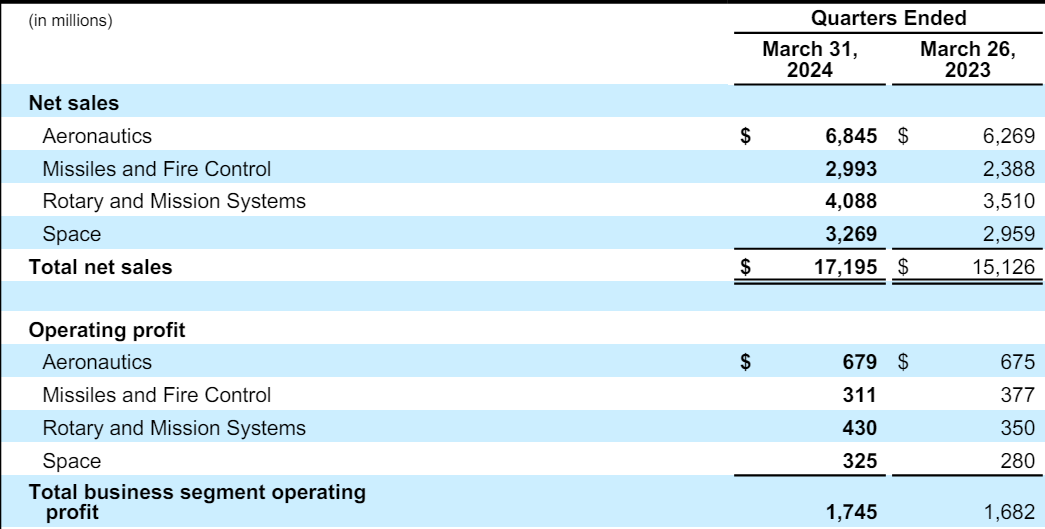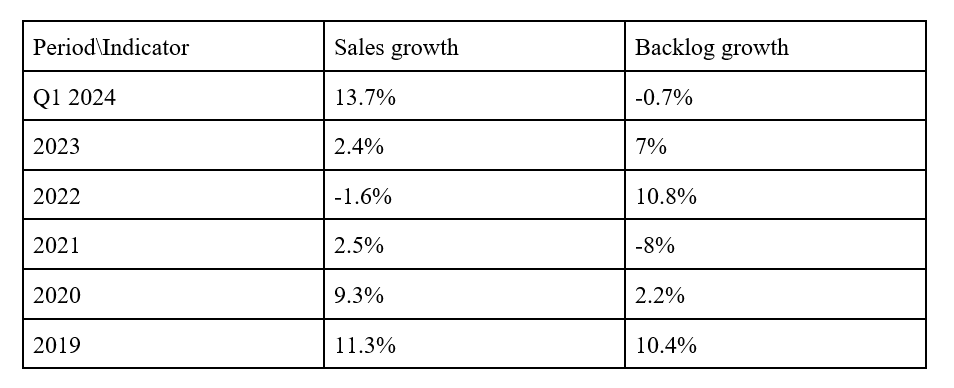It has been well documented that companies maintaining continued success in public procurement, also enjoy more predictability in their cash flow, and are generally more financially stable in insecure times. As discovered in our Government Receivables as a Stock Market Signal white paper, winning government contracts is also likely to have a positive impact on a company’s stock price.
Therefore, we thought it would benefit our readers if we offered them detailed analyses of the financial results these major government contractors achieve.
It is now time for us to look again at a company we covered previously in this series. Lockheed Martin recently reported its Q1 2024 results and below we will provide a brief analysis of the company’s recent performance, covering the increase in sales, the decline in backlog, as well as Lockheed Martin’s government contracts exposure.
To read our analyses of Lockheed Martin's results in the previous two quarters, please follow the links below:
Part 1: Lockheed Martin: Soft 2023 Expected Before Growth Resumes in 2024
Part 26: Lockheed Martin: Strong Start to 2023 Driven by the Space Segment
Key points:
* Lockheed Martin delivered sales growth of 13.7% in Q1 2024 but kept its 2024 outlook unchanged at +2.5%;
* Adjusted EPS of $6.33/share down 1.6% Y/Y, impacted by higher interest rates;
* The company continues to distribute cash to shareholders in excess of its free cash flow, tapping debt markets at rates between 4.5-5.2% during the quarter;
* The 0.7% Q/Q backlog decline could be a sign of improved manufacturing capacity but also waning demand for Lockheed Martin’s products;
* 92.5% of Lockheed Martin’s 2023 revenues came from government contracts, with the U.S. government accounting for 73% of all sales.
Lockheed Martin Q1 2024 Results Overview
We previously covered Lockheed Martin's Q4 2023 results in part 58 of our Top Government Contractors series here. Below we will provide an update on how the company performed during the first quarter of 2024.
Lockheed Martin reports results in four key segments, namely Aeronautics at 39.8% of Q1 2024 net sales, Missiles and Fire Control at 17.4%, Rotary and Mission Systems at 23.8%, and Space at 19% of Q1 2024 net sales:
Figure 1: Sales breakdown between segments

Source: Lockheed Martin Q1 2024 Press Release
Operational Overview
Aeronautics saw sales increase by 9.2% Y/Y in Q1 (2023 +1.8%), driven by increased production volumes, particularly in the F-35 program.
The operating margin of 9.9% in Q1 was down Y/Y and relative to the 10.3% 2023 full-year average, resulting in a 0.6% higher operating profit.
As usual, the main margin drivers were changes in net favourable profit adjustments, as well as increased material costs.
Missiles and Fire Control was the strongest segment in Q1, with sales soaring 25.3% Y/Y (2023 -0.6%). The increase was the result of higher sales across a number of programs, including the Guided Multiple Launch Rocket Systems (GMLRS), High Mobility Artillery Rocket System (HIMARS), Joint Air-to-Surface Standoff Missile (JASSM), and Long-Range Anti-Ship Missile (LRASM) programs.
Margin performance was very underwhelming, with the 10.4% operating margin down both Y/Y and versus the 13.7% 2023 average, driven by losses on a classified program, as well as unfavourable net profit adjustments. All in all, Q1 operating profit was down 17.5% Y/Y.
Rotary and Mission Systems delivered a 16.5% Y/Y jump in Q1 sales (2023 +0.6%), helped by a new program ramp-up. Higher volumes helped offset unfavourable profit adjustments, with the operating margin up Y/Y to 10.5%, but below the 2023 average of 11.5%. As a result, operating profit was up 22.9% Y/Y in Q1.
Space segment performance was equally robust, with sales increasing 10.5% Y/Y (2023 +9.3%) thanks to growth in strategic and missile defense programs.
The operating margin was 9.9% in Q1, up Y/Y and better than the 2023 9.2% average, driven by higher volumes as well as higher equity earnings from Lockheed’s investment in United Launch Alliance (ULA). This pushed operating profit 16.1% higher Y/Y.
On a company level, revenues increased 13.7% Y/Y (2023 +2.4%), partially driven by an extra week in Q1 2024 relative to the prior-year quarter. Operating profit was 3.7% higher in Q1 while adjusted EPS was $6.33/share in Q1, down 1.6% Y/Y, impacted by higher interest expenses (2023: $27.82/share, +2.2% Y/Y). Free cash flow was $1.3 billion in the quarter (2023: $6.2 billion).
Unchanged 2024 Outlook
Despite the very strong start of the year, Lockheed Martin did not update its 2024 outlook, choosing to observe how operations develop in Q2 which will be impacted by one less working week compared to Q2 2023. Nevertheless, we reckon the company is on track to outperform the midpoint of its current 2024 sales outlook:
Figure 2: Lockheed Martin 2024 Outlook

Source: Lockheed Martin Q1 2024 Earnings Press Release
- Sales are set to grow 2.5% in 2024
- Segment profit is expected to be 1.5% higher (operating profit margin down 0.4% to 10.5%)
- Adjusted EPS is seen 6.5% lower in 2024
- Free cash flow is forecast to be flat relative to 2023
Capital Structure
The company is sticking to its policy of returning over 100% of free cash flow to shareholders, with Q1 2024 shareholder payouts running at about 140% of free cash flow.
As a result, net debt, which ended the quarter at $16.6 billion, is set to continue climbing. Nevertheless, it is still a relatively conservative amount against the market capitalization of $111 billion.
Furthermore, the company was able to tap debt markets at favourable terms in Q1, raising a total of $2 billion, at interest rates of 4.5% for 5-year notes, 4.8% for 10-year notes, and 5.2% for 40-year debt.
Declining Backlog
A weak point in the overall robust Q1 report was the 0.7% Q/Q decline in the company’s backlog to $159 billion:
Figure 3: Lockheed Martin Backlog

Source: Lockheed Martin Q1 2024 Earnings Release
Backlog developments in Q1 2024 were polarized:
- Aeronautics -5.2%
- Missiles and Fire Control -2.9%
- Rotary and Mission Systems +0.8%
- Space +8.4%
On an absolute basis, Aeronautics still accounts for the largest share of the backlog, at 35.8%. The book-to-bill ratio was 0.9 in Q1 2024.
The backlog decline observed in Q1 2024, coupled with rising sales of about 13.7%, is in contrast to the trend observed in 2022-2023, and more in line with the 2020-21 period:
Figure 4: Lockheed Martin backlog and sales evolution, 2019-2024
Source: Lockheed Martin Investor Materials
We will continue to monitor Lockheed Martin’s backlog in a bid to evaluate whether the trend set in Q1 2024 is due to government contract awards timing, or rather the result of a structural shift in demand for the company’s products.
Government Contracts Exposure
No update was released on government exposure with the set of Q1 2024 results, but as per the company’s annual report, in 2023, government customers accounted for about 92.5% of Lockheed Martin’s revenue, including:
- 73% to the U.S. government
- 19.5% to international governments
International commercial customers made up 6.5% of total sales, while U.S. commercial customers accounted for just 1% of total company revenue.
To view all Lockheed Martin's contract awards since 2010, request a free sample of TenderAlpha's government contracts data.
Conclusion
Lockheed Martin delivered robust topline performance in Q1 2024, with the 13.7% sales growth helped by an extra week during the quarter. Even after this calendar effect, sales are running above management’s 2.5% outlook in 2024, putting the company in a good position to outperform its topline expectations.
The margin performance was more nuanced, with operating profit growing 3.7% Y/Y. The declining backlog is on the one hand, evidence of the efforts the company has put to boost production, but also potentially a sign of waning future demand.
In 2023, government contracts accounted for about 92.5% of Lockheed Martin’s total revenue. In light of the fact that government customers make up such a large portion of Lockheed Martin's revenue, monitoring the company’s public procurement activity appears to be a smart move that can provide key insights into its financial health.
To get a free sample of the government contracts awarded to Lockheed Martin and other established government suppliers, get in touch now!
This article was written by members of TenderAlpha's team and does not serve as a recommendation to buy Lockheed Martin or any other stock. TenderAlpha is not receiving compensation for it and we have no business relationship with any company whose stock is mentioned in this article.

